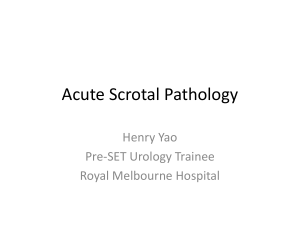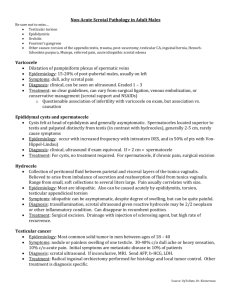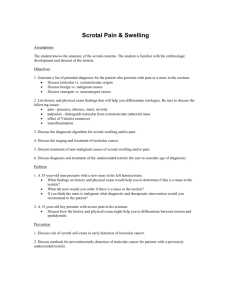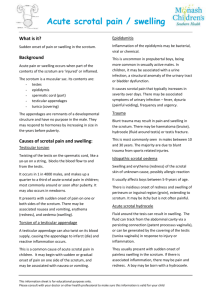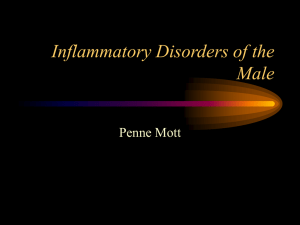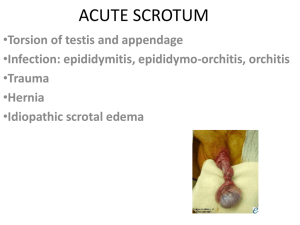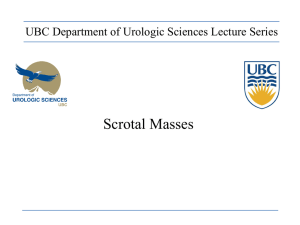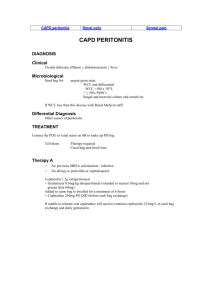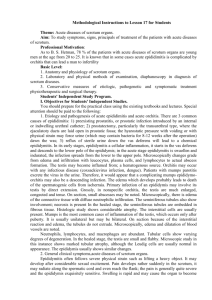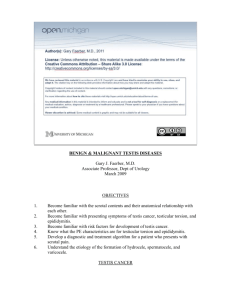Quandaries in Diagnosis and Management of Acute Scrotum A
advertisement
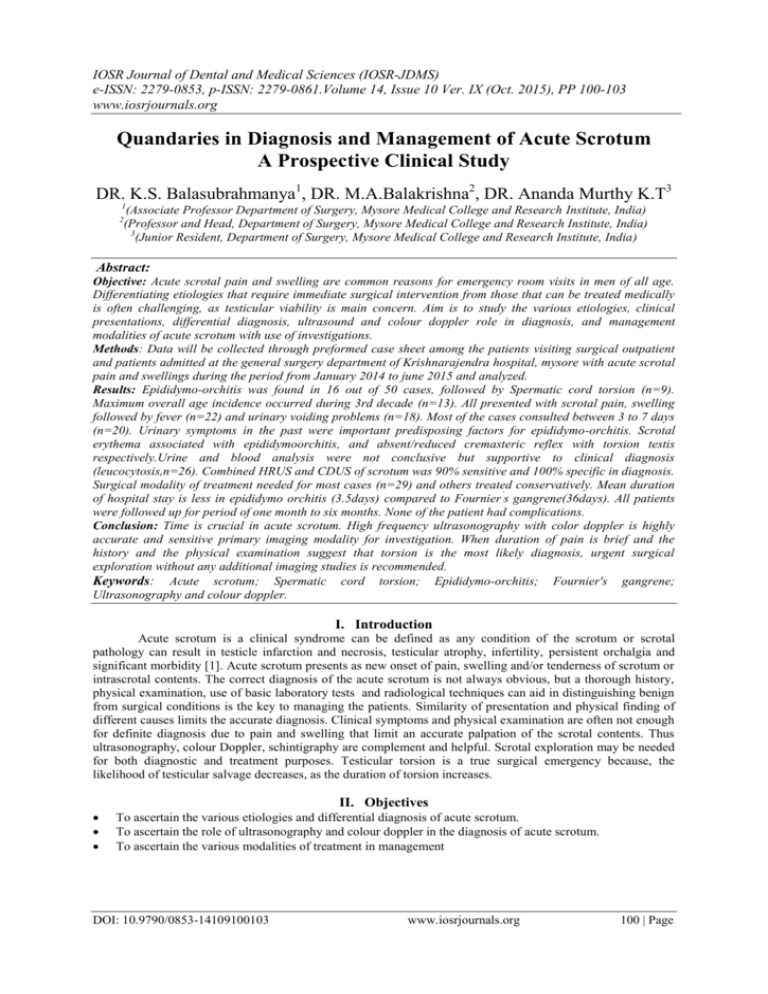
IOSR Journal of Dental and Medical Sciences (IOSR-JDMS) e-ISSN: 2279-0853, p-ISSN: 2279-0861.Volume 14, Issue 10 Ver. IX (Oct. 2015), PP 100-103 www.iosrjournals.org Quandaries in Diagnosis and Management of Acute Scrotum A Prospective Clinical Study DR. K.S. Balasubrahmanya1, DR. M.A.Balakrishna2, DR. Ananda Murthy K.T3 1 2 (Associate Professor Department of Surgery, Mysore Medical College and Research Institute, India) (Professor and Head, Department of Surgery, Mysore Medical College and Research Institute, India) 3 (Junior Resident, Department of Surgery, Mysore Medical College and Research Institute, India) Abstract: Objective: Acute scrotal pain and swelling are common reasons for emergency room visits in men of all age. Differentiating etiologies that require immediate surgical intervention from those that can be treated medically is often challenging, as testicular viability is main concern. Aim is to study the various etiologies, clinical presentations, differential diagnosis, ultrasound and colour doppler role in diagnosis, and management modalities of acute scrotum with use of investigations. Methods: Data will be collected through preformed case sheet among the patients visiting surgical outpatient and patients admitted at the general surgery department of Krishnarajendra hospital, mysore with acute scrotal pain and swellings during the period from January 2014 to june 2015 and analyzed. Results: Epididymo-orchitis was found in 16 out of 50 cases, followed by Spermatic cord torsion (n=9). Maximum overall age incidence occurred during 3rd decade (n=13). All presented with scrotal pain, swelling followed by fever (n=22) and urinary voiding problems (n=18). Most of the cases consulted between 3 to 7 days (n=20). Urinary symptoms in the past were important predisposing factors for epididymo-orchitis. Scrotal erythema associated with epididymoorchitis, and absent/reduced cremasteric reflex with torsion testis respectively.Urine and blood analysis were not conclusive but supportive to clinical diagnosis (leucocytosis,n=26). Combined HRUS and CDUS of scrotum was 90% sensitive and 100% specific in diagnosis. Surgical modality of treatment needed for most cases (n=29) and others treated conservatively. Mean duration of hospital stay is less in epididymo orchitis (3.5days) compared to Fournier’s gangrene(36days). All patients were followed up for period of one month to six months. None of the patient had complications. Conclusion: Time is crucial in acute scrotum. High frequency ultrasonography with color doppler is highly accurate and sensitive primary imaging modality for investigation. When duration of pain is brief and the history and the physical examination suggest that torsion is the most likely diagnosis, urgent surgical exploration without any additional imaging studies is recommended. Keywords: Acute scrotum; Spermatic cord torsion; Epididymo-orchitis; Fournier's gangrene; Ultrasonography and colour doppler. I. Introduction Acute scrotum is a clinical syndrome can be defined as any condition of the scrotum or scrotal pathology can result in testicle infarction and necrosis, testicular atrophy, infertility, persistent orchalgia and significant morbidity [1]. Acute scrotum presents as new onset of pain, swelling and/or tenderness of scrotum or intrascrotal contents. The correct diagnosis of the acute scrotum is not always obvious, but a thorough history, physical examination, use of basic laboratory tests and radiological techniques can aid in distinguishing benign from surgical conditions is the key to managing the patients. Similarity of presentation and physical finding of different causes limits the accurate diagnosis. Clinical symptoms and physical examination are often not enough for definite diagnosis due to pain and swelling that limit an accurate palpation of the scrotal contents. Thus ultrasonography, colour Doppler, schintigraphy are complement and helpful. Scrotal exploration may be needed for both diagnostic and treatment purposes. Testicular torsion is a true surgical emergency because, the likelihood of testicular salvage decreases, as the duration of torsion increases. II. Objectives To ascertain the various etiologies and differential diagnosis of acute scrotum. To ascertain the role of ultrasonography and colour doppler in the diagnosis of acute scrotum. To ascertain the various modalities of treatment in management DOI: 10.9790/0853-14109100103 www.iosrjournals.org 100 | Page Quandaries In Diagnosis And Management Of Acute Scrotum A Prospective Clinical Study III. Materials and Methods Source of Data: Data will be collected through preformed case sheet among the patients visiting surgical outpatient and patients admitted at the general surgery department of Krishnarajendra hospital, Mysore with acute scrotal pain and swellings or any other patients referred for such complaints during some other ailment during the period from January 2014 to June 2015. Method of collection of data: History, physical examination, laboratory investigations, imaging studies, operative procedures and complications (including mortality) will be entered in preformed case sheet and analyzed. Patients will be followed for one month (two days once) or for longer period whenever necessary. A total of 50 cases will be studied. Inclusion criteria: Patients with acute pain and swellings in the scrotum History duration < two weeks Above age of twelve completed years Exclusion criteria: Patients with painless scrotal swelling. History duration >2 weeks. Below the age of twelve years. IV. Observation and Results Epididymo-orchitis was found in 16 out of 50 cases, followed by Spermatic cord torsion (n=9), epididymitis (n=7),Fournier's gangrene (n=7),scrotal hematoma (n=4),scrotal wall abscess (n=3), incarcerated hernia(n=2) and each case of hemorrhage into hydrocele and torsion of testicular appendage. Most common etiology is epididymo-orchitis (32%) followed by testicular torsion (18%). Maximum overall age incidence occurred during 3rd decade (n=13) followed by 5 th decade (n=10).Six out of nine spermatic cord torsion cases presented to us were in pubertal age group. No cases found over 70 years. The mean age of patients with epididymo-orchitis (47.5 years) was significantly higher than in those with torsion (21.1 years).Mean age of Fournier’s gangrene was 42.7 years. Every patient presented as scrotal pain and swelling .Fever (n=22) and urinary voiding problems like dysuria (n=18) were next symptoms more common in patients with epididymitis and epididymo-orchitis than in patients with torsion. Nausea/vomiting and pain abdomen were associated with torsion and also with obstructed inguinal hernia. Fournier’s gangrene patients had blackening of scrotal skin. Most of the cases consulted between 3 to 7 days (n=20).30% of the patients presented in second week. Unfortunately all torsion cases visited 1 day after except one, so testis could not be salvaged in them. Onset of pain was insidious and indolent course in all patients of epididymitis, epididymo-orchitis, and was sudden with progression in all patients with testicular torsion. The average duration of pain at presentation was longer in patients with epididymo-orchitis (8.5 days) than in patients with torsion (2.7days).Trauma and obstructed hernia cases presented within two days of symptoms. Most of the patients (n=22) had right sided symptoms and bilateral in 24% of the cases. Epididymo orchitis found to be more common on right side but no significant laterality in torsion of testis. Fournier ’s gangrene and traumatic cases presented as diffuse scrotal swellings. Urinary symptoms (dysuria / irritative voiding) in the past were important predisposing factors for epididymo-orchitis, present in 40%of the cases visited. Two cases of epididymitis gives history of trivial trauma.One case of torsion and 3 cases of epididymo-orchitis had similar complaint in past. All scrotal hematoma cases had traumatic event before. Bladder catheterization for BOO (n=4) and exposure to STD (n=2) were less common factors. For remaining 14 cases no predisposing factors present. Among the physical findings, tenderness and scrotal mass present in all cases. There was considerable overlap of clinical signs in different aetiologies.Cremasteric reflex absent/reduced in all torsion cases but present in overall 64%of the cases, could not be evaluated in Fournier’s gangrene, hernia and hydrocele cases. Erythema was present(n=34) in most of inflammatory conditions (68%). Phrehn,s sign that is on elevation of affected side scrotum reduces pain present in most of the cases(n=25) of epididymo-orchitis and epididymitis, so as the indurated /enlarged epididymis in 24 cases. Testis enlarged in 18 cases. 36% of the patients were febrile at the time of presentation. In all men with torsion testis high up testis with change in lie and thickened/twisted spermatic cord were constantly present (n=9). Fournier’s gangrene patients had gangrene of scrotal skin (n=6) and dehydration (n=4) during visit. Inguinal lymphadenopathy and B/L pitting edema of leg found in 6 and 3 cases respectively. Leukocytosis (n=26) and pyuria (n=22) were more common in patients with epididymitis and epididymo-orchitis than in patients with torsion.12 patients were diabetic in which 4 with Fournier’s gangrene and two with scrotal abscess.Escherichia coli was cultured in 6 and proteus in 4 patients from urine. Urine culture yielded growth in 1 patient with testicular torsion. Microscopic hematuria was there in 8 cases. DOI: 10.9790/0853-14109100103 www.iosrjournals.org 101 | Page Quandaries In Diagnosis And Management Of Acute Scrotum A Prospective Clinical Study Scrotal ultrasonography and doppler was done on all patients. Combined HRUS and CDUS of scrotum was 90% sensitive and 100% specific in diagnosis,100%sensitive in differentiating torsion from other conditions.15 out of 16 cases of epididymo orchitis cases diagnosed by sonology, like varying degrees of enlargement and hypoechogenicity of the testis and epididymis were reported. All scrotal exploration cases of orchidectomy/orchiopexy were diagnosed as torsion before hand by Doppler as varying degrees of enlargement of the testis and absent blood flow. Out of 7 Fournier’s gangrene cases 6 were diagnosed by ultrasonography. One hematoma case report came as scrotal wall edema. In hydrocele, torsion of testicular appendage and one case of incarcerated hernia ultrasound failed in diagnosis accurately. Overall 45 out of 50 cases were diagnosed correctly by sonological means. Out of 23 cases of epididymitis and epididymo-orchitis 20 treated conservatively and two cases of small hematoma.44% of the cases managed conservatively. Patients treated conservatively responded well with complete recovery.Surgical modality of treatment needed for most cases (n=28).Of 9 cases of spermatic cord torsion surgical exploration done on emergency basis, but we were able to salvage only one patient testis. Bilateral orchiopexy done for that patient. For remaining 8 cases affected side orchidectomy and contra lateral orchiopexy done. Out of 7 cases of Fournier’s gangrene, only debridement was carried out in 2 patients. Multiple debridements followed by secondary suturing in 4 cases and skin grafting in 1 case was carried out. Scrotal exploration with evacuation of haematoma and repair of ruptured testis was carried out in 2 patients .Incision and drainage of scrotal abscess was carried out in all cases. Scrotal exploration with drainage of abscess done in each case of complicated epididymitis and epididymo-orchitis. Reduction hernioplasty done for incarcerated inguinal hernia, excision of testicular appendage, and jaboulay procedure for hemorrhage into hydrocele carried out. In surgically treated patients, post operative recovery was uneventful in 26 cases with cases 2 developing wound infection as a complication managed successfully with antibiotics. All patients were followed up for period of one month to six months. None of the patient had complications and no significant testicular atrophy. Most of epididymo-orchitis and epididymitis (n=18) are treated on outpatient basis. Hospital stay was slightly longer in patients with Spermatic cord torsion (5.1 days) compared to patients with epididymo-orchitis (3.5 days). Patients with Fournier’s gangrene, the average hospital stay was 31 days. The average hospital stay in patients with conservative treatment was 3 days. In other cases treated surgically, the average hospital stay was 8.2 days. V. Discussion The main objective in patients with acute scrotum is to diagnose testicular torsion without delay, towards which clinical evaluation seems to be very useful. Torsion of the testis, torsion of a testicular appendage, epididymo-orchitis and epididymitis are the most common causes of acute scrotum, contributing more than 85% of the causes. The incidence of torsion occurs with an incidence of about 1 in 4,000 boys aged less than 25 years. It is often unilateral, more often on the left side, but it also may be bilateral. Torsion of a testicular appendage occurs at a frequency of 30–45% of causes of acute scrotum and is common in the prepubertal period. Epididymitis occurs in 30–50% of causes of acute scrotum and usually affects postpubertal boys worldwide.[2,3] Age of the patient is an important factor .In general, appendage torsion is most common after infancy and before puberty whereas epididymitis and spermatic cord torsion are most common in the perinatal and pubertal periods. Nature of onset and duration of pain is another important factor. Onset was usually insidious in epididymoorchitis and epididymitis, sudden in testicular torsion, and variable in other causes. The majority (86.9%) of patients with epididymoorchitis and epididymitis were managed conservatively. The testis was salvaged in only one patient among nine with testicular torsion .This may be due to ignorance, financial constraints, and delay in referral by the physicians.[4] Epididymo-orchitis was the commonest cause of acute scrotum in our series. The majority of cases settle with conservative management. The reported incidence of complications ranges from 3 to 39% depending on the severity of the infection.[5] The maximum incidence occurred between the age group of 31-40 years. In study conducted by A.S. Cass & B.P Cass,the maximum incidence was 62%. The mean age for the occurrence for epididymo-orchitis was 47.5 yrs which differs from the study conducted by N.A. Watkin(21.3 Yrs.). The mean age for the occurrence Fournier's gangrene was 42.7 yrs. which differs with study conducted by R.B.Jones. et al(51.3yrs).[6,7] Our series found that clinical profile were not absolute to identify the cause of scrotal pathology due to signs and symptoms overlap among different categories. This result supported by Murphy et al. and Sidler et al. results. The most common symptoms in our series were pain and swelling (100%), as in Ibrahim et al. (78.5%) .[8,9,10] DOI: 10.9790/0853-14109100103 www.iosrjournals.org 102 | Page Quandaries In Diagnosis And Management Of Acute Scrotum A Prospective Clinical Study In study conducted by Ricardo C. Del Villar 23 of 45 cases, history of similar complaints in the past was found in 2 cases of epididymitis & in 6 cases of torsion testis. Also there was history of trauma in 7 cases of epididymitis & in 3 case of torsion testis. Dysuria were present in 7 cases of epididymitis and in 1 case of torsion. Fifteen per cent of these boys had an abnormal urinalysis.Of the 50 abnormal urine sediments, 43 (86%) occurred in boys with acute epididymitis. Almost one-half of the total leukocyte counts were greater than 10,000/mm3 [11].Kass et al, in a studies of over 77 cases, found that there is no necessity for routine surgical exploration of all with acute scrotum. But in one-third of cases, the differential diagnosis of acute scrotum by history and physical examination is difficult and requires a rapid diagnostic tool.[12] Color Doppler sonography yielded a positive and negative predictive value of 100% each for torsion, whereas, 93.9 and 70.6% for epididymo-orchitis, respectively; a sensitivity and specificity of 100% for torsion, whereas, for epididymo-orchitis it was found to be 86.1 and 85.7%, respectively. High frequency real time sonography is clearly superior to clinical diagnosis. Color Doppler sonography is highly sensitive in diagnosing acute scrotal pathology and accurately differentiates testicular ischemia/torsion from acute inflammatory diseases.[13,14] Khaleghnezhad-Tabari and Baghaeipour, and Khaleghnejad-Tabari et al in their studies of over 83 children found that testicular torsion occurred in 37% and appendage torsion in 17%. In the first study, orchiectomy was done in ten cases (32%) and testicular appendectomy in 14 cases (17%). Of those cases, 80% presented more than 8 hours after the onset of symptoms. The testis preservation rate was 68%, while it was 11.1% in our study.[15,16] VI. Conclusion Time is crucial in acute scrotum. One should always think of early exploration when the viability of testis is doubtful. High-frequency ultrasonography and color Doppler sonography is an extremely valuable tool in evaluation of scrotal and testicular pathologies. When duration of pain is brief and the history and the physical examination suggest that torsion is the most likely diagnosis, urgent surgical exploration without any additional imaging studies is recommended. When it is not possible to diagnose or exclude testicular torsion definitely or when the duration of pain is more than 12 hours, then color Doppler ultrasonography can provide significant information. Education of the general public, inclusion of this topic in school health education programs may also help increase awareness of this condition. Training of medical officers and other primary health care providers to recognize the condition and refer as quickly as possible to a surgeon who could manage the condition is important. References [1] [2] [3] [4] [5] [6] [7] [8] [9] [10] [11] [12] [13] [14] [15] [16] Willam C S. Acute scrotal pathology. Surg Cl N America 1982; 62 (6) : 955-970. Patalay V.R., Torsion of spermatic cord, Indian Journal of Surgery,1980, Vol.31, pp.631-635. Lee L.M.et al. Testicular torsion in the adult; Journal of Urology,1983, Vol.130, pp. 93-95. Fawzi Abul Hilal Al-Sayer Narayanaswamy Arun .The Acute Scrotum:A Review of 40 Cases ;KuwaitMed Princ Pract 2005;14:177–181 DOI: 10.1159/000084636 Revised: September 15, 2004 . Luzzi GA, O’BrienTS: Acute epididymitis. BJU Int 2001; 87: 747–755. Jones R B,Hirschmann J V, Brown G S, Treamann J A. Fournier's syndrome: Necrotizing subcutaneous infection of the male genitalia. J Urol 1979 ; 122 : 279-282. Watkin N A, Reiger N A, Moisey C U. Is the conservative management of the acute scrotum justified on clinical grounds? Br J Urol 1996; 78 : 623-627. Murphy FL, Fletcher L, Pease P; Early scrotal exploration in all cases is the investigation and intervention of choice in the acute paediatric scrotum. 2006; 22(5): 413–416. Sidler D, Brown RA, Millar AJ, Rode H, Cywes S; A 25 year review of the acute scrotum in children. SAMJ, 1997; 87(12): 16961698Ann Ital Chir 2002;73(1):65–68. Ibrahim AG, Aliyu S, Mohammed BS, Ibrahim H; Testicular torsion as seen in University of Maiduguri Teaching Hospital, North Eastern Nigeria. Borno Medical Journal, 2012; 9(2): 31-33 Ricordo G. Del Villar, Ireland G W, Cass A S. Early Exploration in acute testicular conditions. J Urol 1972 ; 108 : 887-888. Kass EJ, Stone KT, Cacciarelli AA, Mitchell. Do all children with an acute scrotum require exploration? J Urol. 1993;150(2 Pt 2): 667–669. R, Pasupuleti B, Kamaraju SK, Jukuri N. Sonological Evaluation of Scrotal Pathology by High Resolution Ultrasound and Color Doppler. Int J Med Res Rev 2015;3(1):90-96. doi: 10.17511/ijmrr.2015.1.022. Agrawal AM, Tripathi PS, Shankhwar A, Naveen C. Role of ultrasound with color Doppler in acute scrotum management. J Family Med Prim Care. 2014 Oct-Dec;3(4):409-12. doi: 10.4103/2249-4863.148130. Khaleghnezhad-Tabari A, Baghaeipour MR. Surveying the acute scrotum in children. Pejouhandeh. 2001;6(1(21)):71–74. Khaleghnejad-Tabari A, Mirshermirani A, Rouzrokh M, et al. Early exploration in the management of acute scrotum in children. Iran J Pediatr. 2010;20(4):466–470. DOI: 10.9790/0853-14109100103 www.iosrjournals.org 103 | Page
